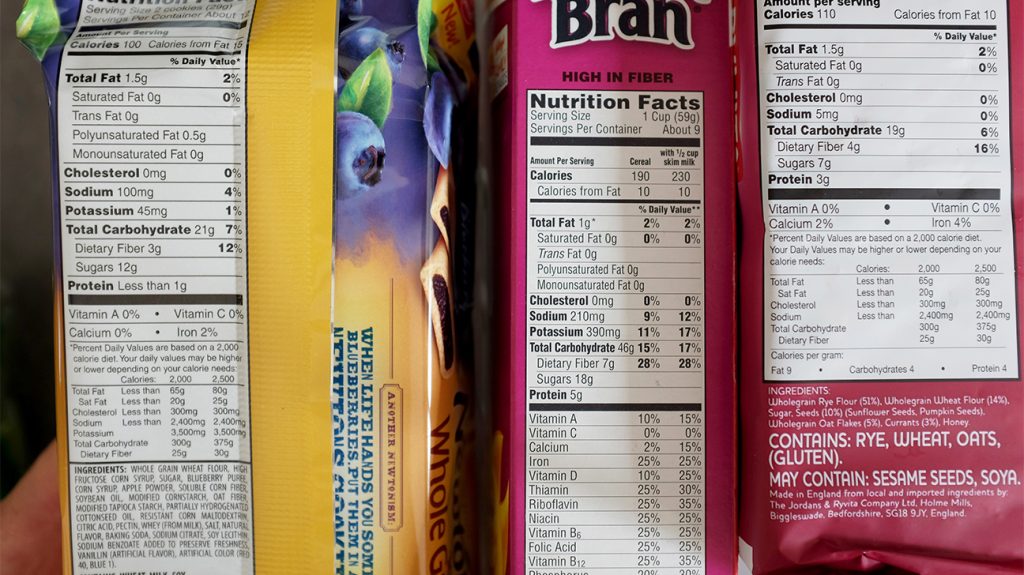Nutrition labels are a valuable tool for making informed food choices and supporting overall health and well-being. However, navigating the information presented on these labels can sometimes be overwhelming, especially with the abundance of terms, numbers, and percentages. In this comprehensive guide, we’ll break down the components of nutrition labels, decode common terms and terminology, and provide practical tips for using nutrition labels to make healthier choices.
- Understanding Serving Sizes:
One of the first things to pay attention to on a nutrition label is the serving size. Serving sizes are standardized portions of food that allow for easy comparison between products. It’s important to note that the serving size listed on the label may not always match the portion size you typically consume. Be sure to check the serving size and adjust the nutritional information accordingly based on how much you plan to eat.
- Pay Attention to Calories:
Calories provide a measure of the energy content of a food or beverage and are an important consideration when managing weight and overall calorie intake. The number of calories per serving is prominently displayed on the nutrition label, making it easy to compare products and make informed choices. Keep in mind that the number of calories listed is based on the serving size indicated on the label.
- Assess Macronutrients:
Macronutrients are the three main components of food that provide energy: carbohydrates, protein, and fat. The nutrition label provides information on the grams of each macronutrient per serving, as well as the percentage of the Daily Value (DV) for each nutrient. Pay attention to the types and amounts of macronutrients in the foods you consume and aim for a balanced intake of carbohydrates, protein, and healthy fats.
- Monitor Added Sugars:
Added sugars are sugars that are added to foods and beverages during processing or preparation and contribute to overall calorie intake without providing any nutritional benefits. The nutrition label now includes a separate line for added sugars, making it easier to identify foods that are high in added sugars. Limiting consumption of added sugars can help reduce the risk of obesity, type 2 diabetes, and other chronic diseases.
- Evaluate Sodium Content:
Sodium is a mineral that is essential for health, but consuming too much sodium can increase the risk of high blood pressure, heart disease, and stroke. The nutrition label provides information on the amount of sodium per serving, as well as the percentage of the DV. Be mindful of the sodium content of packaged and processed foods, as they are often high in sodium. Aim to choose foods that are lower in sodium and use herbs, spices, and other flavorings to enhance the taste of your meals.
- Look for Fiber:
Fiber is an important nutrient that supports digestive health, helps regulate blood sugar levels, and may reduce the risk of heart disease and certain types of cancer. The nutrition label provides information on the amount of dietary fiber per serving, as well as the percentage of the DV. Aim to choose foods that are high in fiber, such as fruits, vegetables, whole grains, legumes, nuts, and seeds, to support overall health and well-being.
- Check the Ingredient List:
In addition to the Nutrition Facts panel, it’s important to check the ingredient list when evaluating packaged foods. Ingredients are listed in descending order by weight, with the main ingredient listed first. Pay attention to the types and sources of ingredients, and be wary of foods that contain added sugars, unhealthy fats, artificial additives, and preservatives. Aim to choose foods with simple, whole food ingredients and minimal processing.
- Use Percent Daily Value (%DV) as a Guide:
The %DV on the nutrition label indicates how much a nutrient in a serving of food contributes to a daily diet based on a 2,000-calorie-per-day diet. Use the %DV as a guide to help you determine whether a food is high or low in a particular nutrient. As a general rule, aim for foods that provide at least 20% of the DV for fiber, vitamins, and minerals and less than 5% of the DV for added sugars and unhealthy fats.
- Be Mindful of Serving Size Adjustments:
If you consume more or less than the serving size listed on the nutrition label, you’ll need to adjust the nutritional information accordingly. For example, if the serving size is one cup, but you consume two cups, you’ll need to double the calories and nutrients listed on the label. Pay attention to portion sizes and adjust the nutritional information accordingly based on your individual needs and preferences.
- Consider Your Overall Dietary Pattern:
While nutrition labels are a useful tool for making informed food choices, it’s important to consider your overall dietary pattern and lifestyle when evaluating foods. Focus on consuming a variety of nutrient-dense foods, including fruits, vegetables, whole grains, lean proteins, and healthy fats, and limit consumption of processed and packaged foods that are high in added sugars, unhealthy fats, and sodium. Use nutrition labels as a guide to help you make healthier choices, but remember that they are just one piece of the puzzle when it comes to overall nutrition and health.
Conclusion:
Nutrition labels are a valuable tool for making informed food choices and supporting overall health and well-being. By understanding the components of nutrition labels, decoding common terms and terminology, and using practical tips for navigating nutrition labels, you can make healthier choices and improve your diet quality. Pay attention to serving sizes, calories, macronutrients, added sugars, sodium, fiber, ingredient lists, %DV, serving size adjustments, and your overall dietary pattern when evaluating foods. With practice and awareness, you can become a pro at navigating nutrition labels and making choices that support your health and well-being for years to come.
Read More: Brad Pitt’s Persistence Navigating the Vineyard Dispute with Angelina Jolie
